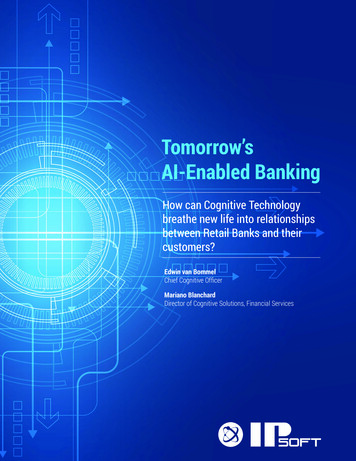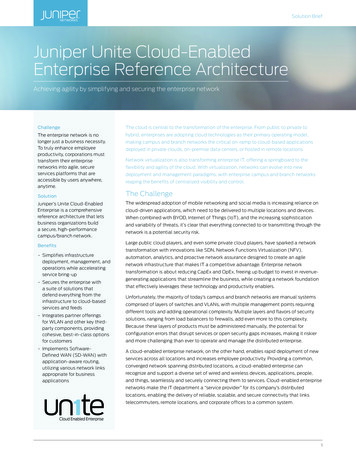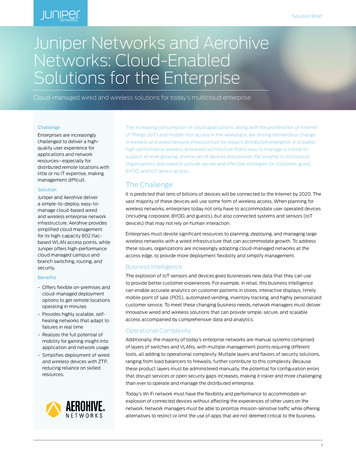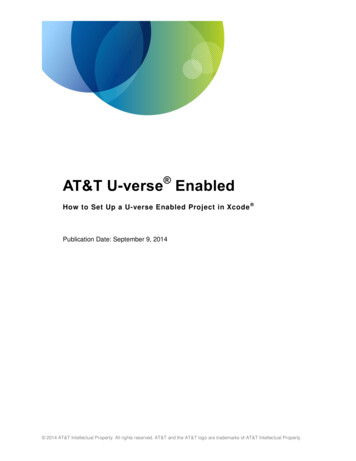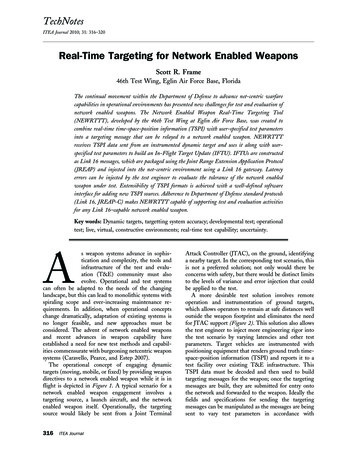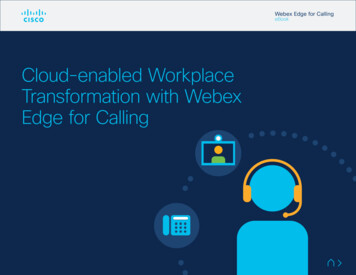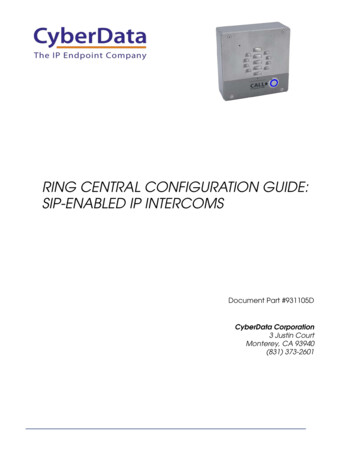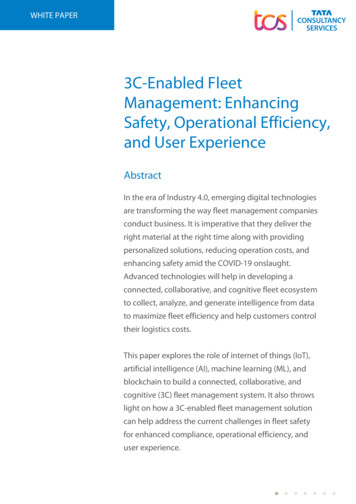
Transcription
WHITE PAPER3C-Enabled FleetManagement: EnhancingSafety, Operational Efficiency,and User ExperienceAbstractIn the era of Industry 4.0, emerging digital technologiesare transforming the way fleet management companiesconduct business. It is imperative that they deliver theright material at the right time along with providingpersonalized solutions, reducing operation costs, andenhancing safety amid the COVID-19 onslaught.Advanced technologies will help in developing aconnected, collaborative, and cognitive fleet ecosystemto collect, analyze, and generate intelligence from datato maximize fleet efficiency and help customers controltheir logistics costs.This paper explores the role of internet of things (IoT),artificial intelligence (AI), machine learning (ML), andblockchain to build a connected, collaborative, andcognitive (3C) fleet management system. It also throwslight on how a 3C-enabled fleet management solutioncan help address the current challenges in fleet safetyfor enhanced compliance, operational efficiency, anduser experience.
WHITE PAPERBuilding a Cognitive, Collective, and CollaborativeFleet Management SystemAs technology has evolved over the decades, so has fleet management,which today is underpinned by digital technologies such as artificialintelligence, IoT, digital twin, conversational platforms, augmented andvirtual reality, wearable technology, and blockchain. The convergence ofthese technologies will make fleet management connected, collaborative,and cognitive (3C).To enable 3C in fleet management, firms need to implement acloud-based fleet management software (FMS) to perform end-to-endoperations over the life cycle of the fleet (see Figures 1 and 2). In fact,demand for cloud-based FMS is projected to expand at a compoundedannual growth rate of 11.3% reaching 34 billion in 20251.Digital suranceTraffic/weatheralertsVehicle theftpreventionVehicle healthmonitoringDigital FleetManagementAutonomousfleet safetyUsage-basedVehicle-as-a-serviceVirtual personalassistanceDriver stressSimulated driver management Autonomoustrainingfleet operationFleet lferage preventionELDmonitoringRoadsidevehicle bot assistanceFreight AggregationAssetutilizationFleet planning& schedulingDriver availabilityon requestLong TermShipment conditionmonitoringReal-timefleet trackingInternet ofThingsVirtual Reality/Augmented RealityRoutemanagementDriver behavioranalyticsBackhaulschedulingShort TermRFIDParts failurepredictionTCO g DataConversationalPlatformArtificial IntelligenceFigure 1: Technologies enabling 3C fleet managementHowever, building an intelligent fleet management system that equipsorganizations with valuable insights for autonomous decision-makingrequires leveraging the right technology such as IoT and AI. Devicesmounted on vehicles continuously transmit data that can be collected andshared with other IoT devices or with standard cloud platforms at apredefined interval. This data can be processed to infer intelligence anddevelop an ingenious system that provides real-time visibility on fleetoperations, empowering fleet management systems to identify operationalinefficiencies in a connected fleet ecosystem. Such a connected systemenhances collaboration among stakeholders such as fleet owners, fleetmanagers, original equipment manufacturers (OEMs), drivers, shippers,[1]Markets and Markets; Fleet Management Market by Solution, Service, Deployment Type, Fleet Type, and Region Global Forecast to 2025; June 2020; Accessed July 13, 2020; leet-management-systems-market-1020.html
WHITE PAPERgovernment agencies, and financial institutions. While IoT helps build acohesive system, AI makes the system intelligent by transforming theconnected system into a cognitive one with machine learning, reasoningskills, and natural language communication. This helps process complexdata types such as sensor data, videos, images, and global positioningsystem (GPS) data to generate intelligence in real-time. However, here,systems require initial training based on historical patterns and learningsto predict the unseen future. This in turn helps in clear decision-making,mitigating the risk of failure and improving fleet operations productivityby leveraging the following:DynamicroutingVehicle healthmonitoringFuel/cargopilferage preventionELDmonitoringRoadsidevehicle assistanceDriver stressSimulated driver management Autonomoustrainingfleet operationFleet ltilingualchatbot assistanceFreightAggregationAssetutilizationFleet planning& schedulingDriver availabilityon requestRoutemanagementDriver behavioranalyticsBackhaulschedulingLong TermVehicle theftpreventionVirtual raffic/weatheralertsDigital FleetManagementAutonomousfleet safetyShort TermReal-timefleet trackingUsage-basedinsuranceParts failurepredictionTCO analyticsFueloptimizationImmediateShipment conditionmonitoringFigure 2: Connected, collaborative, and cognitive (3C) fleet managementEmbrace Autonomous Safety for Enhanced ComplianceIn the COVID-19 era, safe fleet operations are one of the highestpriorities. In fact, in the US, over 160,000 large truck collisionsoccurred during 2019, resulting in 3% fatalities2. At the same time,with the US Federal Motor Carrier Safety Administration (FMCSA)relaxing the electronic logging device (ELD) regulations, drivers aredriving for longer hours to ensure continuity of the supply chain,resulting in fatigue3. 3C-enabled fleet management minimizes therisk of incidents by tracking the driver’s condition and monitoringstress levels in real-time. For example, heart rate sensors installed inhand clip devices can relay data about the driver’s body state andexternal ambient conditions. Similarly, eyelid/retina movementsand facial expressions can be observed from wearable glasses andcameras. In addition, a cognitive system can analyze a driver’s[2]Federal Motor Carrier Safety Administration; Analysis and Information: Crash Statistics; l Motor Carrier Safety Administration; US Department of Transportation Issues National EmergencyDeclaration for Commercial Vehicles Delivering Relief in Response to the Coronavirus Outbreak; March 13, ration-commercial-vehicles
WHITE PAPERcondition using real-time data, correlating it with historical drivingpatterns to predict possible accidents and trigger safety alerts orhelp the driver apply vehicle brakes indigenously when required.The fleet management system also manages warehouse operationsand safety compliance inside a yard. According to the latest dataavailable with the US Bureau of Labor Statistics4, between 2011 and2017, more than 75 fatal injuries and more than 7,500 non-fatalincidents, including with forklifts, happen inside the factory.Connected forklift fleets enabled with IoT sensors, actuators,cameras, and radars connect the entire warehouse ecosystem, andhelp in the identification and prevention of accidents due tohidden/unseen objects. For instance, a cognitive system allowsforklifts to detect any possible hazards, and make decisions on theirown to regulate speed and avoid fatal and non-fatal injuries. Toensure compliance with COVID-19 safety measures, companies canalso leverage FMS for contactless operations, from the time thevehicle enters the plant to when it exits, keeping track of thedriver’s movements and their touchpoints to trace any possibletransmission of the virus.Leverage Voice-Enabled Fleet OperationsIn the COVID-19 scenario, logistical constraints are changing rapidly,with real-time, accurate information playing a pivotal role inseamless fleet operations. In the current scenario, fleet managersneed to navigate through different and often disparate systems anddashboards to get information on dispatches, drivers, and vehicles.A virtual personal assistant such as Alexa, linked to a 3C-enabledfleet management ecosystem can significantly maximize the fleetmanager’s ability to collect information and improve userexperience. Fleet managers can simply ask a series of questions andget information about dispatches, injuries, violations of safety,operational costs and revenue, daily driver turnover, vehiclemaintenance status, and more. Virtual assistants are not onlyequipped to provide information, but can also assist the fleetmanager in executing numerous tasks. For instance, Alexa caninform fleet managers about a road accident, helping them avoidthe congested route, and share this information with the health,safety, and environment (HSE) department and other stakeholdersfor further investigation.Increase Uptime and Reduce Idle Time3C-enabled fleet management is constantly improving fleetoperational efficiency throughout the fleet life cycle acrossonboarding, operations, and retirement. A blockchain-basedconnected network can leverage the carrier’s data from a[4]US Bureau of Labor Statistics; Occupational Injuries, Illnesses, and Fatalities Involving Forklifts; June 2017.htm
WHITE PAPERdecentralized network to assist associated members in verifyingevery record. This helps fleet operators onboard a carrierimmediately, access the network, and assign load to minimize delayin shipments. In addition, smart contracts maintained in theblockchain help in automatic and faster payments as soon as thedelivery is completed, thus reducing the lead time and delaysassociated with manual invoicing and billing.Similarly, the fleet management system continuously collects alarge amount of data from the vehicles, cargo, and externalstakeholder systems to predict any operational failure. For instance,it can connect to government systems to gather the latestinformation on coronavirus hotspots and use this information forfleet planning to minimize the driver’s exposure to the virus. Inanother scenario, sensors can capture degrading moving parts suchas any damages and oil level drops to predict parts failure andschedule predictive maintenance for vehicles. However, thisscenario can become complex with increasing use of autonomoustrucks in the future, as they use multiple sensors and the failure ofany sensor could be extremely hazardous while the truck is on theroad. It is, therefore, crucial to conduct frequent sensor checks apartfrom regular and predictive maintenance. A cognitive system canconsider such constraints and plan systematic sensor checks atpartnered service centers. This will help reduce idle time andincrease a truck’s uptime.Overcoming Key Challenges for Successful DigitalFleet ManagementThe connected fleet ecosystem encompasses a colossal network ofconnected devices which becomes increasingly complex with the use ofa wide variety of device makes and models. These devices continuouslycollaborate to create a thriving fleet ecosystem. For companies to realizethe full potential of fleet management systems, it is crucial to overcomekey challenges (see Figure 3) including the following:Ensuring data security and data flow: In a connected fleet ecosystem,devices are connected using multiple frequencies and any conflict in thetransmission frequency impacts communication across the ecosystem,resulting in crucial data loss. This requires building trust and ownershipof data in the ecosystem to overcome potential entry points for datahacking and business insights leakage.Synchronizing data: Standardizing data collection templates rapidlysynchronizes assorted data and processes it on the go for real-timedecision-making.
WHITE PAPERImproving device management: Currently, installed wireless devicesneed frequent battery recharging or replacement and any delay inpower backup disconnects the system. This requires better devicemanagement to keep track of device onboarding and maintenance forincreased uptime.Training the system: Improving system intelligence using the right dataset and time frame helps train the system in a precise manner ensuringgreater processing accuracy, before it is applied to live conditions.Data PrivacyCybersecurityLarge Data TypesChallengesfor DigitalFleetEnablementDevice ManagementData Flow ManagementNetwork & CommunicationCognitive TrainingFigure 3: Managing key challenges for successful fleet managementDriving Innovation with Digital Fleet ManagementThe increasing adoption of new-age technologies such as IoT, AI, ML, andblockchain is transforming fleet management into an agile function thatcan continuously learn from a dynamic ecosystem and interact withhumans alike. A 3C-enabled fleet management system not only helpsfleet management companies take advantage of technology but alsoensures data privacy, security, and seamless data communication.With a change in business strategy, transformed cultural mindset,continuous product innovations, and improved infrastructure,organizations can embrace the full potential of digital fleet managementsolutions while ensuring superior fleet operations, healthy workingconditions, and enhanced user experience.
WHITE PAPERAbout the AuthorsAnkur KumarAnkur Kumar is an Assistant Consultantin North America Aero and ProcessManufacturing ISU, Manufacturing &Utilities Business Unit, Tata ConsultancyServices. He has more than seven yearsof experience in supply chain operationsspread across multiple projects. He holdsa Master’s degree in Supply Chain andOperations from NITIE, Mumbai and aBachelor’s degree in MechanicalEngineering. He is a certified supplychain professional (CSCP) from Appics.He also holds certifications from theInternational Supply Chain EducationAlliance as a demand driven planner andleader (CDDP, CDDL).Sachin KheveriaSachin Kheveria is a Business Analyst inNorth America Aero and ProcessManufacturing ISU, Manufacturing &Utilities Business Unit, Tata ConsultancyServices. He has more than six years ofindustry experience and has workedextensively in shared mobility and fleetmanagement. He has offered pragmaticsolutions to customer challenges aroundtransportation, logistics, inventory, andfleet management across industries. Heholds a Master’s degree in Supply Chainand Operations from NITIE, Mumbai and aBachelor’s degree in MechanicalEngineering.ContactVisit the Manufacturing page on www.tcs.comEmail: manufacturing.solutions@tcs.comSubscribe to TCS White PapersAbout Tata Consultancy Services Ltd (TCS)Tata Consultancy Services is an IT services, consulting and business solutions organization thatdelivers real results to global business, ensuring a level of certainty no other firm can match.TCS offers a consulting-led, integrated portfolio of IT and IT-enabled infrastructure, engineeringand assurance services. This is delivered through its unique Global Network Delivery ModelTM,recognized as the benchmark of excellence in software development. A part of the Tata Group,India’s largest industrial conglomerate, TCS has a global footprint and is listed on the NationalStock Exchange and Bombay Stock Exchange in India.For more information, visit us at www.tcs.comExperience certainty.IT ServicesBusiness SolutionsConsultingAll content / information present here is the exclusive property of Tata Consultancy Services Limited (TCS). The content / information contained here iscorrect at the time of publishing. No material from here may be copied, modified, reproduced, republished, uploaded, transmitted, posted or distributedin any form without prior written permission from TCS. Unauthorized use of the content / information appearing here may violate copyright, trademarkand other applicable laws, and could result in criminal or civil penalties. Copyright 2020 Tata Consultancy Services LimitedCorporate Marketing Design Services M 07 20TCS.com RSS: http://www.tcs.com/rss feeds/Pages/feed.aspx?f wFeedburner: http://feeds2.feedburner.com/tcswhitepapers
these technologies will make fleet management connected, collaborative, and cognitive (3C). To enable 3C in fleet management, firms need to implement a cloud-based fleet management software (FMS) to perform end-to-end operations over the life cycle of t

![[MS-OFFMACRO]: Office Macro-Enabled File Format](/img/3/5bms-offmacro-5d-130211.jpg)
![[MS-OFFMACRO2]: Office Macro-Enabled File Format Version 2](/img/3/ms-offmacro2.jpg)
